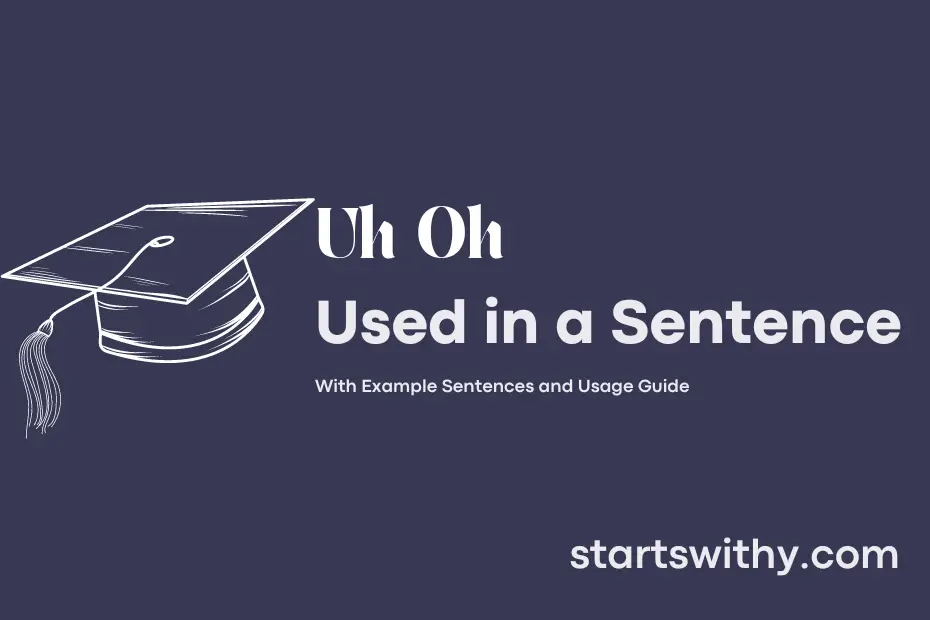Ever found yourself in a tricky situation and blurted out, “uh oh”? This commonly used interjection signifies a moment of realization or concern when something unexpected or unfortunate occurs.
In everyday conversations, we often use “uh oh” to acknowledge a mistake, express mild alarm, or simply convey that things are not going as planned. Its casual and informal nature makes it a versatile phrase that can lighten the mood in various contexts.
7 Examples Of Uh Oh Used In a Sentence For Kids
- Uh oh, I dropped my crayons on the floor!
- Let’s clean up the mess we made, uh oh.
- Uh oh, I forgot my homework at home.
- Look, there’s a big puddle ahead, uh oh!
- Uh oh, I spilled water on my painting.
- Time to pack up our bags, uh oh, it’s almost time to go.
- Uh oh, I think I lost my eraser.
14 Sentences with Uh Oh Examples
- Uh oh, I forgot to submit my assignment before the deadline.
- Looks like I left my notes at home, uh oh.
- Uh oh, I didn’t study at all for this exam.
- Uh oh, my laptop just crashed and I hadn’t saved my work.
- Uh oh, I overslept and missed the morning lecture.
- Uh oh, I accidentally deleted all my important files.
- Uh oh, I think I left my ID card in the library.
- Uh oh, I can’t find my phone anywhere.
- Uh oh, I ran out of printer ink right before printing my project.
- Uh oh, I think I sent the wrong email to the professor.
- Uh oh, I just realized I have a presentation today and I haven’t prepared anything.
- Uh oh, looks like I registered for the wrong course this semester.
- Uh oh, my friend just said the test was postponed and I didn’t know.
- Uh oh, my roommate accidentally spilled coffee on my laptop.
How To Use Uh Oh in Sentences?
Using Uh Oh in a sentence is a great way to express surprise, worry, or concern. Here are some tips on how to incorporate it into your writing or conversation:
-
Placement: Uh Oh is usually placed at the beginning of a sentence to capture attention and convey a sense of immediate reaction to a situation.
-
Punctuation: In writing, you may choose to separate Uh Oh from the rest of the sentence with a comma or an exclamation mark for added emphasis.
-
Tone: The tone of voice plays a crucial role in conveying the right emotion when using Uh Oh. Make sure to match the tone with the context of the situation.
-
Context: Uh Oh is versatile and can be used in various scenarios, such as when you realize you made a mistake, when you see something unexpected, or when you are worried about a possible outcome.
-
Nonverbal Communication: In addition to using Uh Oh in writing, you can also incorporate it into your speech with appropriate facial expressions and body language to enhance the impact.
-
Practice: To become more comfortable with using Uh Oh, try practicing in front of a mirror or with a friend to see how different tones and contexts can change its meaning.
By following these simple tips and incorporating Uh Oh into your expressions, you can effectively convey surprise, concern, or worry in various situations.
Conclusion
In conclusion, the phrase “uh oh” is commonly used to express sudden realization, concern, or worry about a situation. It is often employed in informal or conversational contexts to convey a sense of surprise or mild alarm. Instances like “Uh oh, I forgot to lock the door” or “Uh oh, I think I missed the deadline” illustrate how this verbal expression signifies a moment of recognition of a predicament or mistake.
Whether it’s signaling a mistake or a potential problem, “uh oh” can serve as a quick and effective way to express concern or acknowledge an error. Its simplicity and universality make it a versatile expression in everyday language, succinctly capturing a range of emotions from surprise to apprehension.



